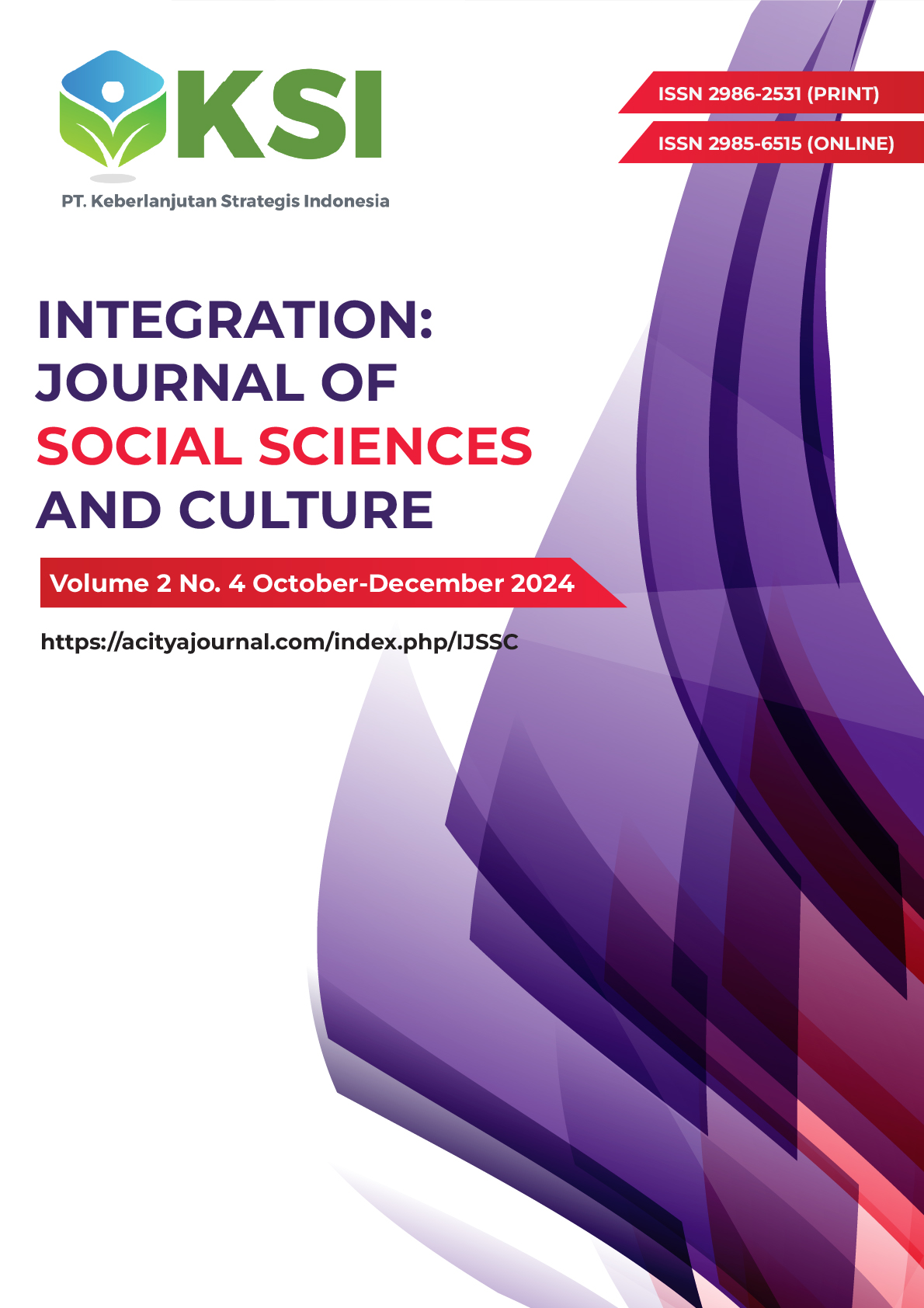Tetfund-Sponsored Training and Development: Effect on Academic Staff Engagement and Productivity in Federal Polytechnic Ado-Ekiti, Ekiti State
DOI:
https://doi.org/10.38142/ijssc.v2i4.256Keywords:
TETFUND, Staff training, Staff engagementAbstract
Purpose:
The purpose of this study is their attempt to evaluate the impact of this noble gesture of TETFund on Nigerian higher education institutions, have conducted studies across the beneficiary institutions to assess the impact of TETFund intervention activities on the beneficiary institutions. It is against this backdrop that this study investigates the impact of TETFund sponsored training and development on the engagement and productivity of academic staff in the Federal Polytechnic Ado-Ekiti.
Methodology:
Four specific research objectives were stated, and while the quantitative research design was employed, collection of data was done from the primary source with the aid of expert-validated questionnaires. Data analysis was carried out using both descriptive (simple percentage and bar charts) as well as inferential statistics (correlation and regression analysis technique).
Findings:
The study revealed that TETFund-sponsored training and development, both by conference attendance and academic degree significantly enhanced staff motivation and loyalty while facilitating increased number and quality of research output conducted and published, and hence, strongly stimulated academic staff engagement and productivity among the academic staff of Federal Polytechnic, Ado-Ekiti.
Implication:
The implication of this is that trained academic staff via TETFund-sponsored training and development are strongly committed, motivated and dedicated to their jobs and better equipped to deliver and conduct high quality lectures and research.
Downloads
References
Abiodun, G.J., (1999). A multiple study investigation of the dimensionality of job involvement. Journal of Vocational Behavior, 19-36.
Abdullahi, M. A., Gwadab, Z. L. & Ibrahim, M. B. (2018). Effect of training and development on employee’s productivity among academic staff of Kano state Polytechnic, Nigeria. Asian People Journal (APJ, 1(2), 264-286.
Abubakar, M. J., Musa, H. S. & Muhammad, G. S. (2019). Impact of tertiary education trust fund’s interventions on staff training and development of institutions in North-west, Nigeria. Al-Hikmah Journal of Education, 6(1), 65-75.
Adamu, Y., Ogu, M. A. & Abudllahi, S. A. (2021) Impact of TETFund Interventions on human capital development in Federal Polytechnics in the North Western Nigeria. EPR. International Journal of Multidisciplinary Research, 7(7), 672-680
Adelere, M. A. (2019). Effect of staff training and development on organisational performance: evidence from Nigerian bottling company. Arabian Journal of Business and Management Review, 6(12), 10-24.
Adeniji, R. F. (2002). Afshan, S., Sobia, I., Kamran, A. & Nasir, M. (2012) Impact of training on employees performance: a study of telecommunication sector in Pakistan Interdisciplinary Journal of Contemporary Research in Business. 4(6).
Akomolafe, C. O. & Fawziyah, B. A. (2019). Academic Staff Training and the challenges of accessing TETFund in Southwest Nigerian Universities. Literacy Information and Computer Education Journal (LICEJ), 10(3), 3271-3277.
Alhasan, A. A. & Mustapha, M. B. (2024). Impact of training and development on employe performance in Federal Polytechnic Nasarawa. International Journal of Novel Research in Physics Chemistry & Mathematics, 11(2), 8-16.
Aminu, K. & Aminu. A. A. (2018). Effect of Tertiary Education Trust Fund (TETFUND) Intervention on the performance of academic staff of Ramat Polytechnic Maiduguri, Borno state, Nigeria International Journal of Multidisciplinary Research, 2(4), 116-125.
Aondofa, C. A. (2022). TETFund sponsored 30,000 lecturers for masters, PhD programmes. Retrieved from https://www.google.com/amp/s/www.theabusites.com/tetfund-sponsored-30000-lecturers-msc-phd/%3famp
Asaba, F. A. (2021). Over N300 billion disbursed to 226 tertiary institutions in 2021. Retrieved from. https://www.google.com/amp/s/www.vanguardngr.com/2021/08/over-n300-billion-disbursed-to-226-tertiary-institutions-in-2021-tetfund-chairman/amp/
Asaju K. (2008). Manpower Training and Development: An Essential Tool for Achieving Organizational Goals. Journal of management and enterprise development, 5(2), 45-54
Eneasator, G.O., Azubuike, K. A. & Orji, F. O. (2019). The effects of manpower development efforts of the Tertiary Education Trust Fund (TET-Fund) on Productivity and Performance of Academic Staff Members of Colleges of Education in Nigeria. American Journal of Creative Education, 2(3), 149-160
Daniel, W. (2010). Individual and contextual influences on multiple dimensions of training effectiveness. Journal of European Industrial Training, 7(3), 282-290.
EduCeleb (2021). 27,383 got TETFund scholarships in 10 years. Retrieved from https://www.google.com/amp/s/educeleb.com/tetfund-scholarship-conferences-2011-2020/amp/
Elena, P. (2000) Employee Development through self-development in three retail banks. Journal of Personnel Review 29 (4): 491-508.
Ezekwe, E. A. & Ani, K.J. (2024). Impact of Tertiary Education Trust Fund intervention in academic staff training and development within the South East public universities. African Journal of Development Studies (AJDS), 14(2), 249 – 261.
Harvey, M. (2002). Human Resources Management in Africa: Alice’s Adventures in Wonderland. International Journal of Human Resources Management. 13(7), 1119 – 1145.
Ipe, M. (2003). Knowledge sharing in organizations: A conceptual framework, Human Resource Development Review, 2(4), 337-359.
Irene, F. L. (2009). A Thesis on the Impact of Training and Development on the Worker Performance and Productivity in the Public Sector Organizations: A case study of Ghana Ports and Harbours Authority, (Submitted Thesis), Institute of Distance Learning: KNUST
Jehanzeb, K., & Bashir, N. A. (2013). Training and development program and its benefits to employee and organization: A conceptual study. European Journal of Business and Management, 5(2), 243-252.
Kinicki, A. & Kreitner, R. 2007. Organizational Behavior, New York. McGrawHill.
Kolawole, S. A. (2019). Human resource management practices and employee engagement in manufacturing firms in Nigeria, Published Ph.D Thesis. Kenya: Jomo Kenyatta University of Agriculture and Technology.
Kraak, A. (2005). Human Resources Development and the Skills Crisis in South Africa: the Need for Multi-pronged Strategy. Journal of Education and Work 18(1) 57–83.
Larry E.U & Joseph O.N (2014). Tertiary Education Trust Fund interventions and Sustainable Development in Nigerian Universities: Evidence from Ebonyi State University, Abakalik: Journal of Sustainable Development; 7(4), 23-35.
Liu, Z. A. (2016). Study on the development of structure model of engagement for knowledge employee. Business management, 11, 65-69.
Iorkpiligh, I.T., Jato, S.T. & Ogah, O. (2024). Impact of Tertiary Education Trust Fund (TETFUND) on academic staff development to all benefiting tertiary institutions in Benue state of Nigeria. International Journal of Novel Research in Physics Chemistry & Mathematics,11(2), 8 – 16
Gallup Organization (2008). What your disaffected workers cost. Gullup Management Journal. Retrieved from www.gallup.com.
Njoku, R. (2007). Human Resource Management, Aba: Cheedal Global Prints
Nwachukwu, C. (1998). Personnel Administration in Organization, Port Harcourt: Uniport Press.
Nassazi, N. (2013) Effects of training on employee performance: Evidence from Uganda, Unpublished Ph.D Thesis. Vassa Finland: University of Applied Sciences.
Nasidi, Y., Kamaruddeen, A. M., Barau, L. S., & Nuhu, M. B. (2018). Relationship between Centralization and Construction Waste Disposal among Construction Organization.
Nduagu, N. J. & Saidu, Y. A. (2021). Influence of TETFund intervention on staff and infrastructural development for improving quality tertiary education in Abia State, Nigeria. International Journal of Management Studies and Social Science Research, 3, 1-10.
Macey, W. H., & Schneider, B. (2008). The meaning of employee engagement
Makinde, O., Tayo, F. O. & Olaniyan, T. S. (2018). The effect of employee engagement andeducational qualification on employee productivity in Nigerian Banking industry
Obih, S. O. & Akamike, O. J (n.d.). The emerging myths and realities of human resources and capital development in Nigeria. Proceedings of the 1st International Technology, Education and Environment Conference. African Society for Scientific Research (ASSR
Obisi, C. (1996). Personnel Management. Ibadan: Freman Publications.
Ogunde, A. (2011). Nigerians Spend Over $2 Billion Annually on Foreign Degrees.
Ogunode, N. J. (2023). Impact of Tertiary Education Trust Fund (TETFUND) on tertiary education development in Nigeria. American Journal of Public Diplomacy and International Studies, 01(05), 2993-2157.
Onasanya, F. A.B. (1999). Effective Personnel Management and Industrial Relations, Lagos: CMD
Onyeizugbe C. U, Obiageli L. O &Igbodo R. O (2013). TETFund International Programmes and Academic Staff Development of Selected Universities in South East Nigeria: Journal of Economics and Public Finance, 3(5), 45-54.
Olaniyan, D. A. & Ojo, L. B. (2008). Staff training and development: a vital tool for organisational effectiveness. European Journal of Scientific Research, 24(3) 326-331
Olaniyan, D. A. & Okemakinde, T. (2008). Human capital theory: implications for educational development. Pakistan Journal of Social Sciences, 5(5), 479-483.
Oloruntoba, A. (2006). The Effect of training on employee performance. European Journal of Business and Management 5(4), 2-12
Onichakwe, C. S. (2013). An appraisal of training and development in organizations in Nigeria: employee and organizational growth performance pivotal. International Journal of Development and Management Review, 8(1), 256-264.
Oppong, B. (2017). The perception of training and organisational commitment among staff of Ghana Immigration Service in the Upper West Region. MBA Dissertation, University of Cape Coast
Oyeniyi, A. (2002). Effective Training; Systems, Strategies and Practices; 3rd edition; Lagos.
Oyigbenu, Z. O. (2020). Effect of Employees’ training on performance of academic staff of some selected Tertiary Institutions in Nasarawa State (2011-2017). African Journal of Social Sciences and Humanities Research, 3(6), 65-77
Ozigbo, N. C. (2012) Implications of Human Resources Management and Organizational Culture Adoption on Knowledge Management Practices in Nigerian Oil and Gas Industry, Communications of the IIMA, 12(3), Available at: http://scholarworks.lib.csusb.edu/ciima/vol12/iss3/6
Paul, G. D. & Audu, L. S. (2019). Effects of training of academic staff on employees’ performance in Federal Polytechnics, Nigeria. International Journal of Engineering Technology and Management Research, 6(9), 1-21.
Peretomode, V.F & Peretomode, O. (2001). Human resources management. Lagos: Obaroh and Ogbinaka Publishers Ltd
Perryman, S., & Hayday, S. (2004). The drivers of employee engagement report 408, institute for employment studies, UK
Pitfield, R.C. (2012). Effective human resource development. California: Jossey: Bass Inc. P Publishers.
Psacharopoulos, G. & Woodhall, M. (1997). Education for development: an analysis of investment choice. New York: Oxford University Press
Reid M, Barrington H, & Kenney J. (1992). Training interventions, 2nd ed. London: Institute of Personnel Management; San Francisco, CA:
Rodriguez, J. & Walters, K. (2017). The importance of training and development in employee performance and evaluation. International Journal Peer Reviewed Journal Refereed, 4(25), 202-212.
Rosenwald, M. (2000). Working class: More companies are creating corporate universities to help employees sharpen skills and learn new ones. Boston Globe, H1.
Sakamota, A. & Powers, P. A. (1995). Education and the dual labour market for Japanese men in America. Sociology Review, 60(2), 222-246
Salman, I. (2015). Employees’ perceptions of human resource management practices and Knowledge sharing Beahviour, Published Dissertation. New Zealand: Massey University, Palmerston North.
Saunders, M., Lewis, P. and Thornhill, A. (2009). Research Methods for Business Students. 5th ed. Prentice Hall: London.
Shaw, K. (2005). Employee engagement and creativity. How to build a high performance workforce. Melcrum Publishing Limited.
Sheeba, M. J. & Christopher, P. B. (2020). Exploring the role of training and development in creating innovative work behaviors and accomplishing non-routine cognitive jobs for organizational effectiveness. Journal of Critical Reviews, 7(4), 263-267.
Saks, S. (2006). The Science of Training: A Decade of Progress. Annual Review of Psychology, 52, 471–499.
Sardar, S., Rehman, A., Yousaf, U., & Aijaz, A. (2011). Impact of HR practices on employee engagement in banking sector of Pakistan. Interdisciplinary Journal of Contemporary Research in Business, 2(9), 378-389.
Shulagna S. (2011) A study on employee engagement at manufacturing industries. Global Management Review, 5(3), 45-45.
Shuaibu S. & Abuhuraira A. M. (2024). Assessing the transformative impact of TETFund intervention on academic staff training and development in North-West Nigerian University. Research Journal of Humanities, Legal Studies & International Development, 6(1),
Smart Ways to Increase Employee Engagement. (2018). Smart ways to increase employee engagement. Retrieved from https://www.jobberman.com/discover/employee-engagement
Soane, E., Truss, C., Alfes, K., Shantz, A., Rees, C., & Gatenbytt, M. (2012). Development and application of a new measure of employee engagement: The ISA engagement scale. Human resource development international, 15(5), 529-547.
Sweetland, S. R. (1996). Human capital theory: foundations of a field of inquiry. Review of Educational Research, 66(3), 341-359
Uyeri, A.O., (2016). The relationship between manpower development and lecturers productivity in colleges of education in delta state. Global Journal of Management and Business Research, 16(10), 64-78.
Wilson, A. (2001). Corporate reputation: Seeking a definition, Corporate Communications. An International Journal, 6 (1), 24-30.
Woodhall, M. (1987). Human capital concepts in organisation. Economics of Education Research and Studies, 3(4), 21-24
Vinesh, O. (2014). Role of training & development in an organizational development. International Journal of Management and International Business Studies. 4(2), 213-220.
Yusuf, N.,1, Aminu, G. W., Adeogun, A. S.& Bagava, Y. H. (2020). Influence of training and career development on employee engagement among nonacademic staff of University. International Journal of Intellectual Discourse, 3(2), 383-395.
Downloads
Published
Issue
Section
License
Copyright (c) 2024 Ayodele Damilola OGUNLOKUN, Kehinde AJAO

This work is licensed under a Creative Commons Attribution-NonCommercial 4.0 International License.
Creative Commons Attribution-NonCommercial 4.0 International License.











.png)







